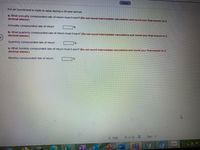
Essentials Of Investments
11th Edition
ISBN: 9781260013924
Author: Bodie, Zvi, Kane, Alex, MARCUS, Alan J.
Publisher: Mcgraw-hill Education,
expand_more
expand_more
format_list_bulleted
Concept explainers
Question

Transcribed Image Text:Saved.
For an investment to triple in value during a 25-year period.
a. What annually compounded rate of return must it eam? (Do not round Intermedlate calculations and round your final answer to 2
decimal places.)
Annually compounded rate of return
b. What quarterly compounded rate of return must it earn? (Do not round Intermedlate calculatlons and round your final onswer to 2
declmal places.)
Quarterly compounded rate of return
c. What monthly compounded rate of return must it earn? (Do not round Intermedlate calculatlons and round your final answer to 2
decimal places.)
Monthly compounded rate of return
Next >
< Prev
15 of 23
connect
PI
T
5
N.
Expert Solution
This question has been solved!
Explore an expertly crafted, step-by-step solution for a thorough understanding of key concepts.
Step by stepSolved in 4 steps

Knowledge Booster
Learn more about
Need a deep-dive on the concept behind this application? Look no further. Learn more about this topic, finance and related others by exploring similar questions and additional content below.Similar questions
- Which comes closest to the future value of $875 to be received at the end of 7 years, if the amount earns an annual interest rate of 4% and is compounded 4 times per year? O $1156.13 O $664.93 O $662.23 O $910.00 O $1151.44 SUBMIT ANSWERarrow_forwardComplete the following using compound future value. Do not round intermediate calculations. Round final answers to the nearest cent. Time principal rate compounded Amount Interest 4 years $15,700 6% quarterly ? ? *Amount and interest need to be solved.arrow_forwardAssume that a one-year CD purchased for $1000 pays an APR of 6% that is compounded semi-annually. How much is in the account at the end of each compounding period? (Calculate the interest and compound it each period rather than using the compound interest formula. Round your answers to the nearest cent.) first period $ second period $ How much total interest does it earn? (Round your answer to the nearest cent.)$ What is the APY? %arrow_forward
- Present value = $100; Interest rate = 5%; Number of years 11 (assume annual compounding). What is the future value? Group of answer choices 171.03 155.00 55.00 223.13 Answer with Explanation and with reason of answer is correct or incorrectarrow_forwardWhat is the future value of $3,500 in 19 years at an APR of 8.8 percent compounded semiannually? (Do not round intermediate calculations and round your answer to 2 decimal places, e.g., 32.16.)arrow_forwardPlease show work. Thank youarrow_forward
- Manually calculate the compound amount and compound interest for the following investment. Round your answers to the nearest cent. Do not round intermediate calculations. Principal TimePeriod (years) NominalRate (%) InterestCompounded CompoundAmount CompoundInterest $7,000 5 6 annually $ $arrow_forwardFind the missing values assuming continuously compounded interest. (Round your answers to two decimal places.) InitialInvestment Annual% Rate Time toDouble Amount After10 Years $ % 15 yr $1600arrow_forwardYou have a choice of investing in a financial instrument that either compounds interest on an annual basis or on a quarterly basis. Which would you choose? Group of answer choices I would prefer simple interest Quarterly compounding I would be indifferent; I would earn the same with either compounding. Annual compoundingarrow_forward
- Manually calculate the compound amount and compound interest (in $) for the investment. Principal TimePeriod (years) NominalRate (%) InterestCompounded CompoundAmount CompoundInterest $1,000 2 10 annually $ $arrow_forwardWhat is the future value of $5,500 in 17 years at an APR of 8.4 percent compounded semiannualy? (Do not round intermediate calculations and round your answer to 2 decimal places, e.g., 32.16.) Future valuearrow_forwardFind the future values of the following ordinary annuities: a. FV of $600 paid each 6 months for 5 years at a nominal rate of 6% compounded semiannually. Do not round intermediate calculations. Round your answer to the nearest cent. $ b. FV of $300 paid each 3 months for 5 years at a nominal rate of 6% compounded quarterly. Do not round intermediate calculations. Round your answer to the nearest cent. $ c. These annuities receive the same amount of cash during the 5-year period and earn interest at the same nominal rate, yet the annuity in part b ends up larger than the one in part a. Why does this occur? 819000.0 The annuity in part (b) is compounded more frequently, therefore, more interest is earned on previously-earned interest. Varrow_forward
arrow_back_ios
SEE MORE QUESTIONS
arrow_forward_ios
Recommended textbooks for you
 Essentials Of InvestmentsFinanceISBN:9781260013924Author:Bodie, Zvi, Kane, Alex, MARCUS, Alan J.Publisher:Mcgraw-hill Education,
Essentials Of InvestmentsFinanceISBN:9781260013924Author:Bodie, Zvi, Kane, Alex, MARCUS, Alan J.Publisher:Mcgraw-hill Education,

 Foundations Of FinanceFinanceISBN:9780134897264Author:KEOWN, Arthur J., Martin, John D., PETTY, J. WilliamPublisher:Pearson,
Foundations Of FinanceFinanceISBN:9780134897264Author:KEOWN, Arthur J., Martin, John D., PETTY, J. WilliamPublisher:Pearson, Fundamentals of Financial Management (MindTap Cou...FinanceISBN:9781337395250Author:Eugene F. Brigham, Joel F. HoustonPublisher:Cengage Learning
Fundamentals of Financial Management (MindTap Cou...FinanceISBN:9781337395250Author:Eugene F. Brigham, Joel F. HoustonPublisher:Cengage Learning Corporate Finance (The Mcgraw-hill/Irwin Series i...FinanceISBN:9780077861759Author:Stephen A. Ross Franco Modigliani Professor of Financial Economics Professor, Randolph W Westerfield Robert R. Dockson Deans Chair in Bus. Admin., Jeffrey Jaffe, Bradford D Jordan ProfessorPublisher:McGraw-Hill Education
Corporate Finance (The Mcgraw-hill/Irwin Series i...FinanceISBN:9780077861759Author:Stephen A. Ross Franco Modigliani Professor of Financial Economics Professor, Randolph W Westerfield Robert R. Dockson Deans Chair in Bus. Admin., Jeffrey Jaffe, Bradford D Jordan ProfessorPublisher:McGraw-Hill Education

Essentials Of Investments
Finance
ISBN:9781260013924
Author:Bodie, Zvi, Kane, Alex, MARCUS, Alan J.
Publisher:Mcgraw-hill Education,



Foundations Of Finance
Finance
ISBN:9780134897264
Author:KEOWN, Arthur J., Martin, John D., PETTY, J. William
Publisher:Pearson,

Fundamentals of Financial Management (MindTap Cou...
Finance
ISBN:9781337395250
Author:Eugene F. Brigham, Joel F. Houston
Publisher:Cengage Learning

Corporate Finance (The Mcgraw-hill/Irwin Series i...
Finance
ISBN:9780077861759
Author:Stephen A. Ross Franco Modigliani Professor of Financial Economics Professor, Randolph W Westerfield Robert R. Dockson Deans Chair in Bus. Admin., Jeffrey Jaffe, Bradford D Jordan Professor
Publisher:McGraw-Hill Education